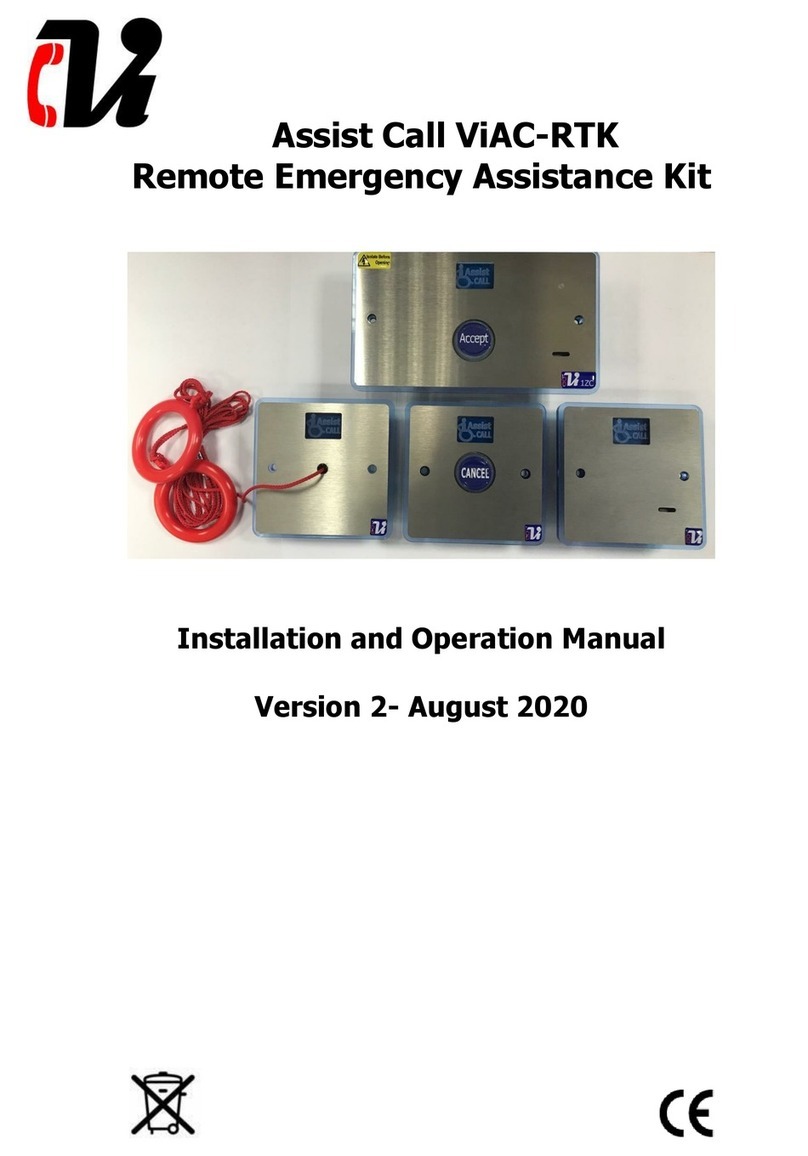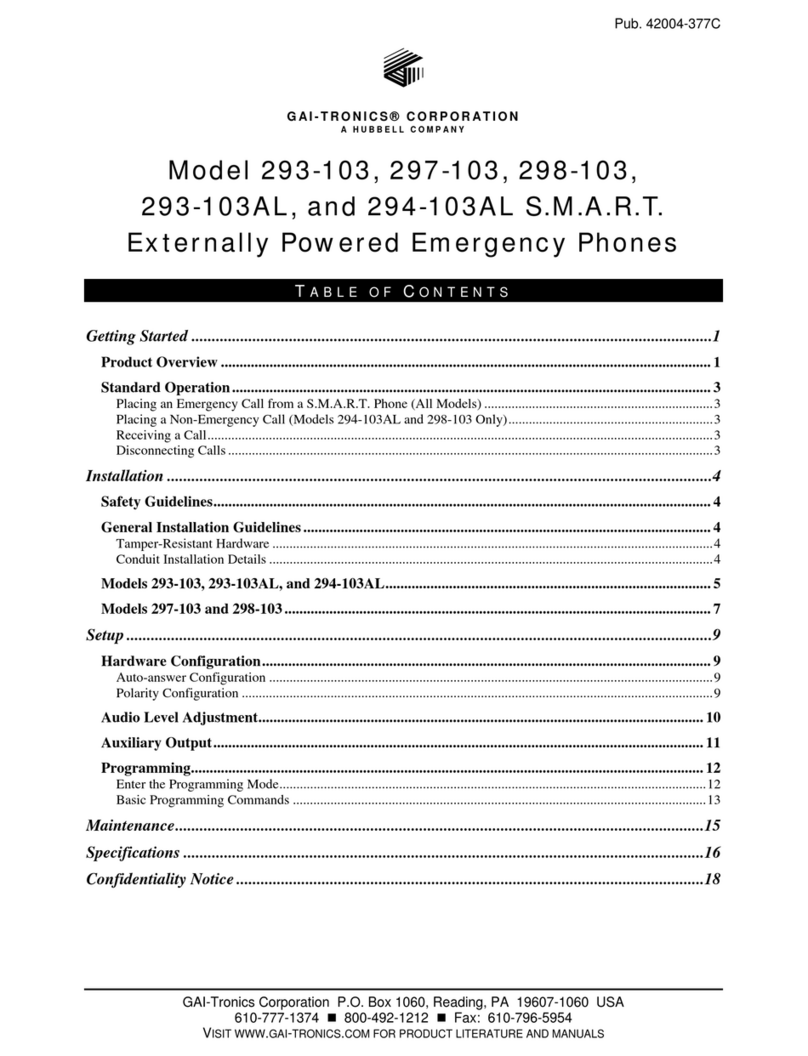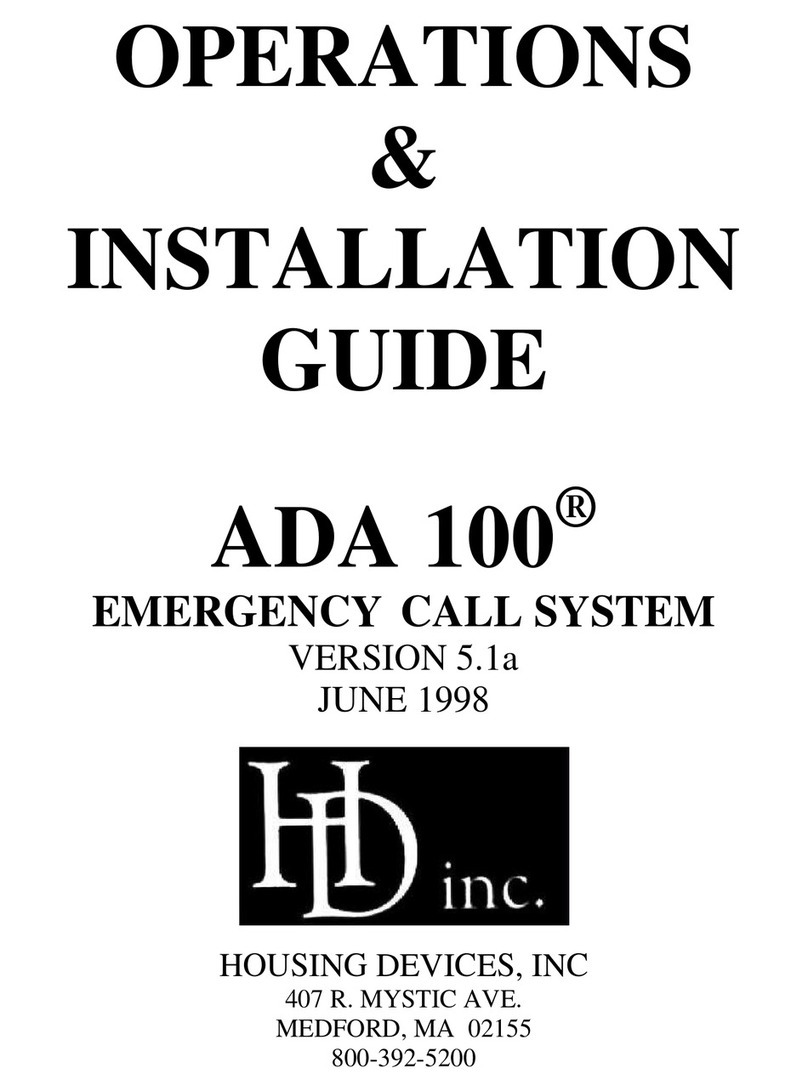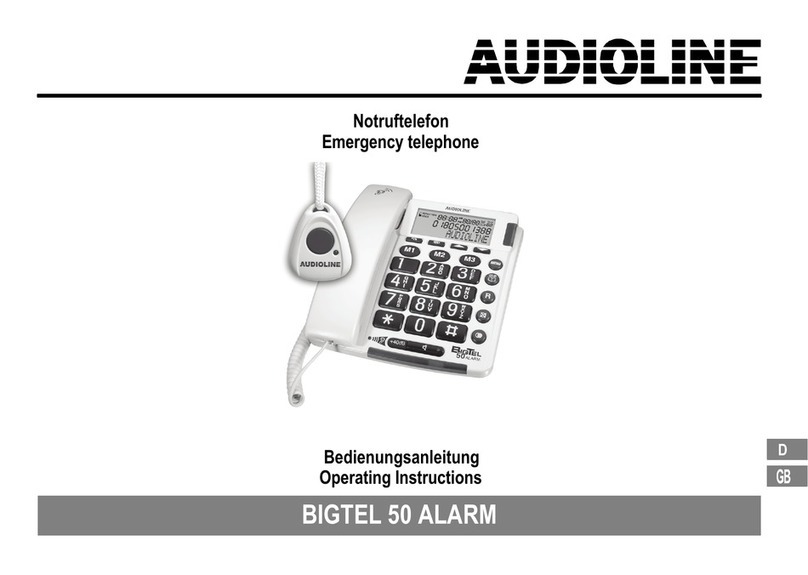Trigon Miniguard HF-2 Series Quick start guide

1220 N. Batavia • Orange, CA 92867
(714) 633-7442 • Facsimile (714) 633-7567
April 30, 2002
Handsfree Telephone Entry / Emergency Autodialer
INSTALLATION
and
OPERATIONAL INSTRUCTIONS
( Firmware Revision #012102 'C' HF2_INFO)
Emergency button w/ 5# rollover, Information button w/ 2# rollover
HF-2 Info Series-

Page 2
HF-2
TABLE OF CONTENTSTABLE OF CONTENTS
TABLE OF CONTENTSTABLE OF CONTENTS
TABLE OF CONTENTS
INTRODUCTION ..................................................................................... 3
PRODUCT OVERVIEW .......................................................................... 3
MOUNTING .............................................................................................. 4
WIRING ..................................................................................................... 4
WIRING DIAGRAM ................................................................................ 5
PROGRAMMING INFORMATION ...................................................... 6
General Programming Information ......................................................... 6
Autodialed Numbers ............................................................................... 6
Site ID Number ....................................................................................... 6
Entering Program Mode .......................................................................... 6
Setting Information and Emergency Telephone Numbers ...................... 6
Setting the Site ID Number ..................................................................... 6
Changing Program Access Number ........................................................ 6
Setting the Relay Duration Timer ........................................................... 7
Setting Incoming Ring Count.................................................................. 7
Setting Dial Mode ................................................................................... 7
Setting Call Legnth ................................................................................. 7
DTMF Echo Test ...................................................................................... 7
Cycling Relays ...................................................................................... . 7
OPERATION
Answering a call from the HF-2.............................................................. 8
Calling the HF-2 to Grant Access ........................................................... 8
TROUBLE SHOOTING GUIDE
General .................................................................................................... 9
CONDENSED GUIDE TO USE and PROGRAMMING
Security Dept. Operation......................................................................... 10
Standard Mode ........................................................................................ 10
Programming the Unit............................................................................. 10
Revision 11501 Approved

Page 3
HF-2
INTRODUCTIONINTRODUCTION
INTRODUCTIONINTRODUCTION
INTRODUCTION
PRODUCT OVERVIEWPRODUCT OVERVIEW
PRODUCT OVERVIEWPRODUCT OVERVIEW
PRODUCT OVERVIEW
If you are using this manual as a programming guide
after the initial installation, you may find the TABLE OF
CONTENTS useful in locating the particular
programming procedure you need.
This manual contains all the information required to
installand program theTRIGON HF-2. If you are using
this manual to install this unit, it is very important to
read all the sections in order.
You should read these instructions before you begin
installation. This will insure that everything is done
efficiently.
TheTELALARM HF-2 Two Button is a multi-number
auto dialer. Upon pressing the 'Information' button,
the HF-2 dials a programmed telephone number. If the
number dialed is busy or does not answer, the HF-2
will hang up and dial the second programmed number.
If the last programmed number is busy or does not
answer, the HF-2 will rollover and start the dialing
process again with the first phone number.
Upon pressing the 'Help' button, the HF-2 dials the first
programmed telephone number. If the number dialed
is busy or does not answer, the HF-2 will hang up and
dial the second programmed telephone number. If
unanswered the HF-2 will continue dialing up to five
numbers.
The HF-2 comes standard with one output relay. This
relay is programmed to stay latched on for the duration
of a "HELP" call in order to operate a remote strobe
light.
A Site I.D. code feature provides for unit identification.
The Site I.D. code is a programmable four digit code
that is transmitted by the HF-2 when it receives a
command from the called party. This code, when
interpreted by a Trigon DTMF Decoder, will identify
the calling unit.
Figure 1
TRIGON
TRIGON ELECTRONICS
ORANGE CA.
INFO
HF-2
12"
4.2" 2.0"
Telephone Line-
Voice Grade 24 to 48V
22 AWG;Shielded
or Twisted,2 Conductor
Camera, Dooror Gate
Secondary
Relay
SerialPrinter
(18 AWG; Shielded, 3 Conductor)
Postal
Lock
Box
Primary
Output
Relay
Main Entrance
Power Cabling -
Shielded or Twisted,
2 Conductor,
18AWG up to 250'
16AWG up to 500'
Alarm
Shunt
Relay
HELP

Page 4
HF-2
WIRINGWIRING
WIRINGWIRING
WIRING
MOUNTINGMOUNTING
MOUNTINGMOUNTING
MOUNTING
avoid ground loops, do not ground the shield at both
ends. Use 600V insulated wire for this installation.
7. Isolate the Telco phoneline from 12 VAC power
wires. This will prevent 60 Hz hum from occurring
on the phoneline. Use 22 AWG wire on Telco line
run distances of up to 2400 feet. Consult the factory
for distances greater than 2400 feet.
8. Power Relays 1 and 2 are dry contact, Form C type,
rated for 5 AMPS @ 30 VDC/ 250VAC.
9.The Shunt relay is a low-power (4 watt) reed relay.
It can be used for temporary alarm switch bypass,
video camera activation, etc. The Shunt relay
activates with the #1 or #2 power relay, and
deactivates thirty seconds after relay release.
10.Connect printer wiring to the RS-232 port (Printer
IN to RS-232 OUT, Printer BUSY to RS-232 DSR,
Printer COM to RS-232 COM).
11. If all wiring and grounding is completed, mount the
faceplate onto the backbox.
1.Use the wiring diagram (Fig. 3) for wire connection
information.
2.Do not power any other device from the Trigon’s
12 VAC transformer. If a substitute transformer is
used, be sure it is rated 12 VAC, 40VA, UL Class 2
listed. The 12 VAC input power wires should be
18AWG, 600V, insulated wire. This should be
sufficient for distances up to 200 feet.
3. Do not energize wires until installation is completed.
4. Ground the unit by attaching a separate 12 AWG
ground wire to the ground location on the terminal
block. This ground wire should go to a grounding
rod or grounded metal conduit.
5. Trigon recommends that an EMI filter (Cornell-
Dubilier ModelAPF 1021 or equivalent) be mounted
between the 12 VAC transformer output and the unit.
EMI/RFI filters are available from Trigon. Mount
the filter as close to the unit as possible. Ground the
filter to the same point as unit ground.
6. Shielded cable is recommended. Ground the
shielding to the same point as the unit and filter. To
Arrangements must be made with the local telephone
company for installation of a standard voice-grade
telephone line (touch-tone or rotary) as close to the unit
mounting location as possible. The telephone company
may require the following information.
FCC Registration No..................1Z8898-62546-DI-T
Ringer Equivalence..............................................0.8B
Connector............................................Terminal Block
The unit is designed to be as weather resistant as
possible. We do however recommendsome shelter from
direct rain and sunlight. An overhang is usually
sufficient. Bolt the back plate (Fig. 2) to the mounting
surface using the four .312" holes in the chassis. Feed
the wiring through the access hole in the rear of the
back plate. At this point, the wiring should NOT be
live (energized).
Note: If used in extreme weather, a bead of silicon
sealant should be run around the outside top two thirds
of the unit, after the front case is secured.
(Fig. 2b).
.52" 3.62"
+
+
11.80"
5.38"
2.80"
+
+
3.0"
.52"
1.5"
2.02"
1 Hole
.88" Dia.
4 Holes
.312" Dia.
Note: Mount backplate with 1" wire entry hole
toward the bottom. Seal the opening with a
silicone sealant before attaching backplate to surface.
Figure 2
Figure 2b
Seal top 2/3 of case
to mounting surface.
Side View

Page 5
HF-2
WIRING DIAGRAMWIRING DIAGRAM
WIRING DIAGRAMWIRING DIAGRAM
WIRING DIAGRAM
Figure 3
0-250'
500' +
18 AWG; Shielded
16 AWG; Shielded
14 AWG; Shielded
Input power cabling
250 to 500'
IN
OUT
DSR
COM
RS-232
CARD READER
EARTH GROUND
TELEPHONE LINE
EARPHONE
MOUTH
SPEAKER (HF-2)
MICROPHONE (HF-2)
MICROPROCESSOR
AUDIO
SPEAKER
VOLUME
PRIMARY
RELAY
12V AC / DC NO C NC
INPUT
POWER
5 Amp MAX
MEMORY
P
S
G
Telephone line cabling
Voice Grade 24 to 48V
22AWG; Shielded or
Twisted up to 2400'
Busy
Com
Printer
In
RTS
Microphone
Sensitivity
Adjustment
PG
TELALARM HF-2

Page 6
HF-2 PROGRAMMING INFORMATIONPROGRAMMING INFORMATION
PROGRAMMING INFORMATIONPROGRAMMING INFORMATION
PROGRAMMING INFORMATION
General Programming Information
The "Initial Setup" for the HF-2 has been programmed
at the factory. These factory default settings may be
changed to better suit your particular application. If you
decide to alter these settings, follow the instructions
below. It is important that each programming step be
taken in order. When reprogramming a specific feature,
you must always enter the programming mode first. You
may then go to the appropriate procedural steps for the
changes desired.
Record below the autodialed numbers to be programmed
into the HF-2.
NOTE: This symbol: ☎resents response tones sent
from the unit while programming.
Autodialed Numbers
Primary Emergency Number (16 digit max)
__ __ __ __ __ __ __ __ __ __ __ __
Second Emergency Number (16 digit max)
__ __ __ __ __ __ __ __ __ __ __ __
Third Emergency Number (16 digit max)
__ __ __ __ __ __ __ __ __ __ __ __
Fourth Emergency Number (12 digit max)
__ __ __ __ __ __ __ __ __ __ __ __
Fifth Emergency Number (16 digit max)
__ __ __ __ __ __ __ __ __ __ __ __
First Information Number (16 digit max)
__ __ __ __ __ __ __ __ __ __ __ __
Second Information Number (16 digit max)
__ __ __ __ __ __ __ __ __ __ __ __
PROGRAMMINGPROGRAMMING
PROGRAMMINGPROGRAMMING
PROGRAMMING
(A) To Enter Program Mode:
1. Call the telephone number of the unit.
2. Listen for the two second tone.
3. Enter "#" then the unit's Program Code ☎☎.
4. If desired, exit Program Mode by pressing '#'
(wait for two second tone).
5. To terminate call, press '7'.
If the unit is new, use the preset factory code. (Factory
code is 9753).
(B) Setting the Information and Emergency
Telephone Numbers:
1. Unit must be in Program Mode.
2. Press '2' then '1'
☎
and enter the first
Emergency Phone Number. Press '#' when
complete
☎☎
.
Press '2' then '2'
☎
and enter the second
Emergency Phone Number. Press '#' when
complete
☎☎
. Repeat for up to five Emergency
Phone Numbers.
Press '2' then '9'
☎
and enter the first Information
Phone Number. Press '#' when complete
☎☎
.
Press '2' then '0'
☎
and enter the second
Information Phone Number. Press '#' when
complete
☎☎
.
3.To terminate call, press '7 '.
This number identifies the unit upon request from a
central office.
(C) Setting the Site ID Number:
1. Unit must be in Program Mode.
2. Press '1' .
3. Enter a four digit number ☎☎ .
4. If desired, exit Program Mode by pressing '#'
(wait for two second tone).
5. To terminate call, press '7'.
(D) Changing ProgramAccess Number:
Thiswill changethe factory presetnumberof '9753'.
1. Unit must be in Program Mode.
2. Press '3'.
3. Enter a new four digit number ☎☎ .
4. If desired, exit Program Mode by pressing '#'
(wait for two second tone).
5. To terminate call, press '7'.
Site I.D. number)
__ __ __ __

Page 7
HF-2
PROGRAMMING, Cont.PROGRAMMING, Cont.
PROGRAMMING, Cont.PROGRAMMING, Cont.
PROGRAMMING, Cont.
5. If desired, exit Program Mode by pressing '#'
(wait for two second tone).
6. To terminate call, press '7'.
Note: If '0' was programmed for an audible ring, the
call may be answered by pressing the INFO' button on
the face of the unit.
(F) Setting the Dial Mode.
This will select Rotary or Touch-Tone dialing.
1. The unit must be in Program Mode.
2. Press '6'.
3. Press '1' for Rotary.
or
4. Press '0' for Touch-Tone ☎☎.
5. If desired, exit Program Mode by pressing '#'
(wait for two second tone).
6. To terminate call, press '7'.
Note: Adding 2 to the above value will result in the
Secondary relay closing for three seconds at dial time.
(G) Setting Call Length:
Thisis the periodof time allowedfor conversation before
time-out. The time desired is measured in seconds, and
entered using a 3 digit number. (060= 1 minute, 180= 3
minutes, etc).
1. Unit must be in Program Mode.
2. Press '8'.
3. Enter call length in seconds (001 to 999)
☎☎
.
4. If desired, exit Program Mode by pressing '#'
(wait for two second tone).
5. To terminate call, press '7'.
(H) DTMF Echo Test:
1. Press '9'.
The unit will send a tone sequence 1 thru 0 ,*, #, and
then echo any tones received from the caller.
2. To stop test. press '#' (wait for two second tone).
3. To terminate call, press '7'.
(I) Cycling Relays:
This command causes the HF-2 to leave the
programmingmode and operate the primaryrelay timing
cycle followed by phone line disconnect.
1. Press ' '.*
(E) Setting the Relay Duration Timer:
This will set the length of time the Primary and
Secondary relays remain activated. The duration can
be set from 1 to 45 seconds.
Thedurationis set by enteringthenumber of five-second
intervals desired (2= ten seconds).
1. Unit must be in Program Mode.
2. Press '0'.
3. Enter the number of 5 sec. intervals required.
☎☎ .
4. If desired, exit Program Mode by pressing '#'
(wait for two second tone).
5. To terminate call, press '7'.
Note: If '0' is entered in step 3, relays will pulse for one
second.
(H) Setting Incoming Ring Count:
Entering a digit value of 1 to 9 will set the number of
rings the unit will count before answering an incoming
call.
1. Unit must be in Program Mode.
2.Press '5'.
3. Enter the number of rings desired ( 1 to 9).
or
4. Enter '0' if an audible ring is desired from the
HF-2 whenever it is called ☎☎.

Page 8
HF-2
OPERATIONOPERATION
OPERATIONOPERATION
OPERATION
Note: If the wrong Program code is entered, the unit
will immediately hang up. If the program code or other
information is not entered completely, the HF-2 will
time-out and hang up.
When a CALL button is pressed, the HF-2 dials a pre-
programmed phone number and monitors the line for
the following signals:
Busy Signal: The HF-2 will hang up and redial
the number after approximately three busy tones.
Ring Signal: The HF-2 will hang up and redial the
number after approximately six unanswered rings
(36 seconds).
Voice or Touch-tones: This indicates an answer.
The unit then enters the Talk Mode.
Answering the Call From the HF-2
Answer the HF-2 incoming call with a short phrase at
least 3 seconds long. The unit may fail to recognize a
short greeting such as “Hello” and may not turn on the
microphone.
Oncevoicecommunication has been establishedyoumay
then press keys on your touch-tone telephone to do any
of the following:
1. To Activate the Primary Relay and hang up
after time-out, press '0' or '5'.
2. To Activate the Secondary Relay and hang
up after time-out, press '1' or '6'.
Note:Activating either power relay will simultaneously
activate the alarm shunt relay for the relay activation
time plus an additional thirty (30) seconds.
3. To Terminate the Call, press '7'.
4. To Reset the HF-2's Call Length Timer,
press '8'.
Note: The unit will beep twice to warn of auto-call
termination in 10 seconds.
5. To Toggle on/off the Secondary Relay, press
6. To Retrieve the HF-2s Site ID number, press
'#'.
7. To Enter the Program Mode, press '
✽
',
followed by the four digit Programming Code.
Calling the HF-2 To Grant Access
When a call is placed to the HF-2, the caller can perform
any of the above operations with the following
exceptions:
1. To Enter the 'Talk' Mode, press '2' or any of
the above tones.
2. To Activate the Primary Relay, press '0' or '5'.
You will hear one beep. Enter your four digit
Program Code. The relay will activate for the
preset cycle duration, and providing 1 beep per
second until the end of the cycle.
3. To Activate the Secondary Relay and hang
up after time-out, press '1' or '6'.

Page 9
HF-2
NO DIAL TONE
1. Check input power at unit. Should be 12 VAC.
2. Check that unit is properly grounded to a good
Earth ground.
3. Current starved. Increase AC input wire size.
4. Remove power, wait 5 seconds, restore power.
Check for dial tone.
5. Check for phone line. Should be 48-52 VDC
across phone line terminals (on hook).
6. Check VOLUME adjustment on PC board.
7. Check “SPKR” plug on PC board. Make sure
speaker is properly plugged in (Handsfree
units).
8. Verify that contacts and wires are clean and
tight.
CANNOT PROGRAM
1. Incorrect/lost program code.
2. Not entering ' ✽' before program code.
3. Try ‘NO DIALTONE’ troubleshooting
procedures.
4. Check that Program Prom/Microprocessor is
fully seated.
5. Unit is in the wrong Operational Mode
TROUBLE SHOOTING GUIDETROUBLE SHOOTING GUIDE
TROUBLE SHOOTING GUIDETROUBLE SHOOTING GUIDE
TROUBLE SHOOTING GUIDE
LOSES MEMORY
1. Electrical noise on power line. Install EMI/RFI
filter.
2. Excessive electrical noise from strike. Use low
current strike.
3. Unit transformer shared with another device (i.e.
door strike).
RESIDENT CANNOTACTIVATE STRIKE/GATE
1. Tenant not pressing correct number on phone.
2. Strike/gate operator not wired correctly.
3. Missing or incorrect power to strike or gate
operator.
4. Current starved. Increase wire size.
5. Tone may be too brief in duration (cordless
phones, etc.).
AC HUM IN SPEAKER
1. Phone wires running in same conduit asAC
power.
2. Unit not properly grounded.
3. Defective microphone.
RESIDENT CANNOT HEAR VISITOR
1. Defective handset/microphone.
2. Person receiving the call answers in too short a
duration to activate the HF-2 (person must speak
a minimum of 2 seconds to be detected).
3. Excessive background noise.

Page 10
HF-2
PROGRAMMING THE UNIT
Enter the Programming Mode: Call the unit, then
press [✽{pppp}] ☎☎
[0{f}]☎☎ Set unit’s Gate Open time
[1{iiii}]☎☎ Set unit’s Site ID number
[2 then 1-0] ☎[nnn nnn#] ☎☎ Set unit’s Auto dial
numbers
[3{pppp}]☎☎ Set unit’s Program Code
[5{r}]☎☎ Set Ring Count before auto answer
[6{d}]☎☎ Set Dial Mode‡
‡ Dial Mode
0 = Tone dial only
1 = Rotary dial only
2 = Tone dial with Secondary Relay pulse
3 = Rotary dial with Secondary Relay pulse
[7{x}]☎☎ Set Operation Mode, where x = :
0 = Standard mode
1 = Emergency mode
2 = Multiple HF-2’s share same phone line
4 = Ring Down mode (Seizes phone line, waits)
[8{lll}]☎☎ Set Call Length Time Limit
[9(tones)#] Echo Test.
[ ] then 1-0] Verifies primary or backup telephone
numbers
[#] Return to Normal Mode
Legend:
dDial mode (0= Touch, 1= Rotary)‡
fFive second relay duration time (1, 2,…9)
iiii Site ID number (always use four digits)
lll Call Length Time in seconds (001, …999)
nnn nnnn Phone Number (up to 12 digits)
pppp Program Code
rRing Count (1, 2, …9)
✽The “star” key of the telephone
# The “pound sign” key of the telephone
☎Tones returned by the unit
SECURITY DEPT. OPERATION
When Security personnel receive a call from the unit,
they press key [X] on their telephone to:
STANDARD MODE
[0,5] Cycle Primary Relay
[1,6] Cycle Secondary Relay
[2] Factory Tone Test (answer tone)
[7] Force disconnect (hang up)
[8] Extends current Call Timer 3 minutes
[9] Toggle on/off Secondary Relay (☎= off, ☎☎= on)
[#] Requests Site ID Number
[✽{pppp}] Enter Program Mode
General
Databetween [ ]is a mandatoryprogram key strokesequence. Data between { } is to be supplied by theprogrammer.
Unit responses are shown between ( ).
CONDENSED GUIDE TO USE and PROGRAMMINGCONDENSED GUIDE TO USE and PROGRAMMING
CONDENSED GUIDE TO USE and PROGRAMMINGCONDENSED GUIDE TO USE and PROGRAMMING
CONDENSED GUIDE TO USE and PROGRAMMING
✽

Page 11
HF-2
Other manuals for Miniguard HF-2 Series
2
Table of contents
Popular Emergency Phone manuals by other brands
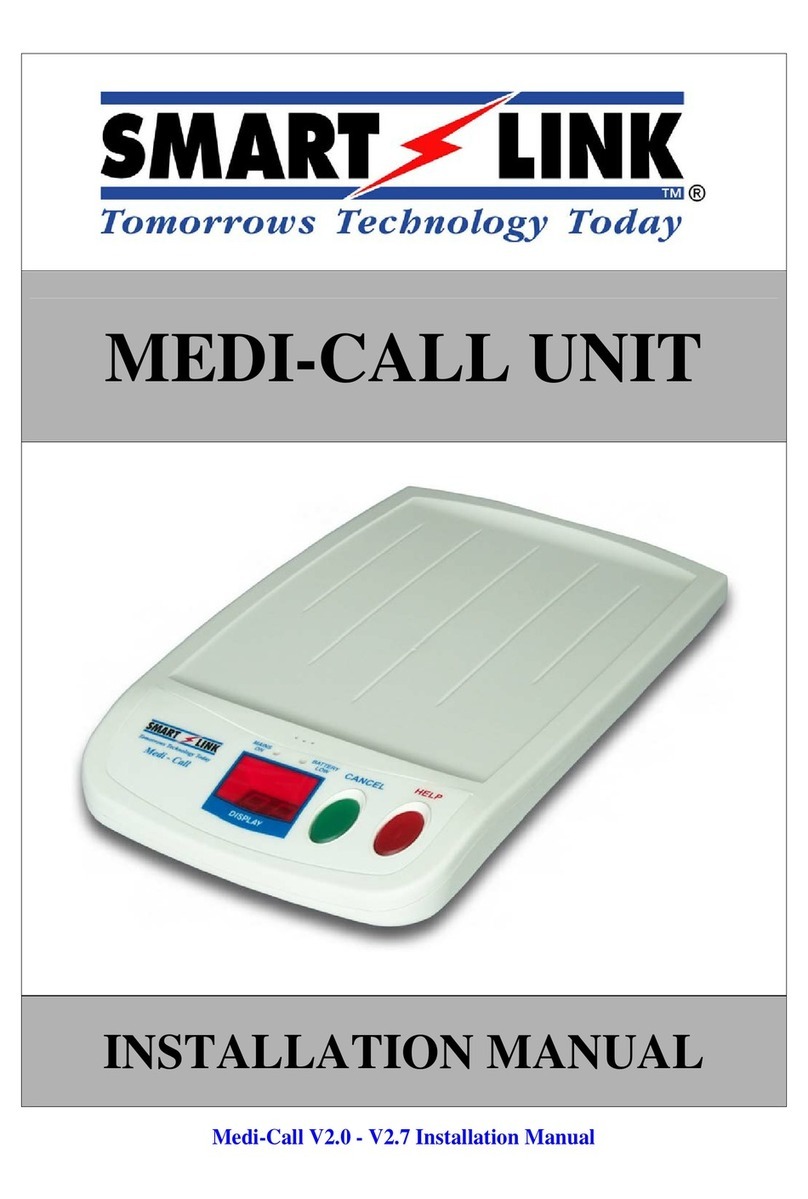
Smartlink
Smartlink MEDI-CALL UNIT installation manual

Alpha Communications
Alpha Communications AlphaECall 100 Series Installation & configuration manual
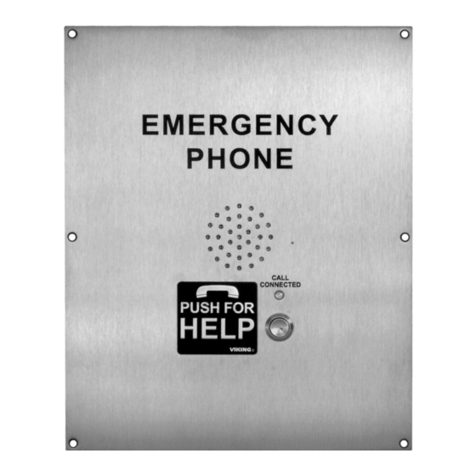
Viking
Viking BLK-3-EWP Technical practice
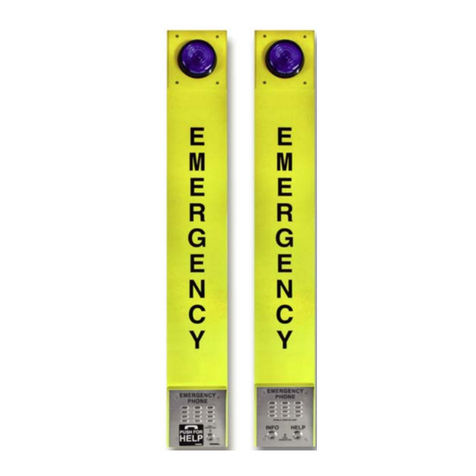
Viking
Viking E-1600A-BLT-EWP Technical practice
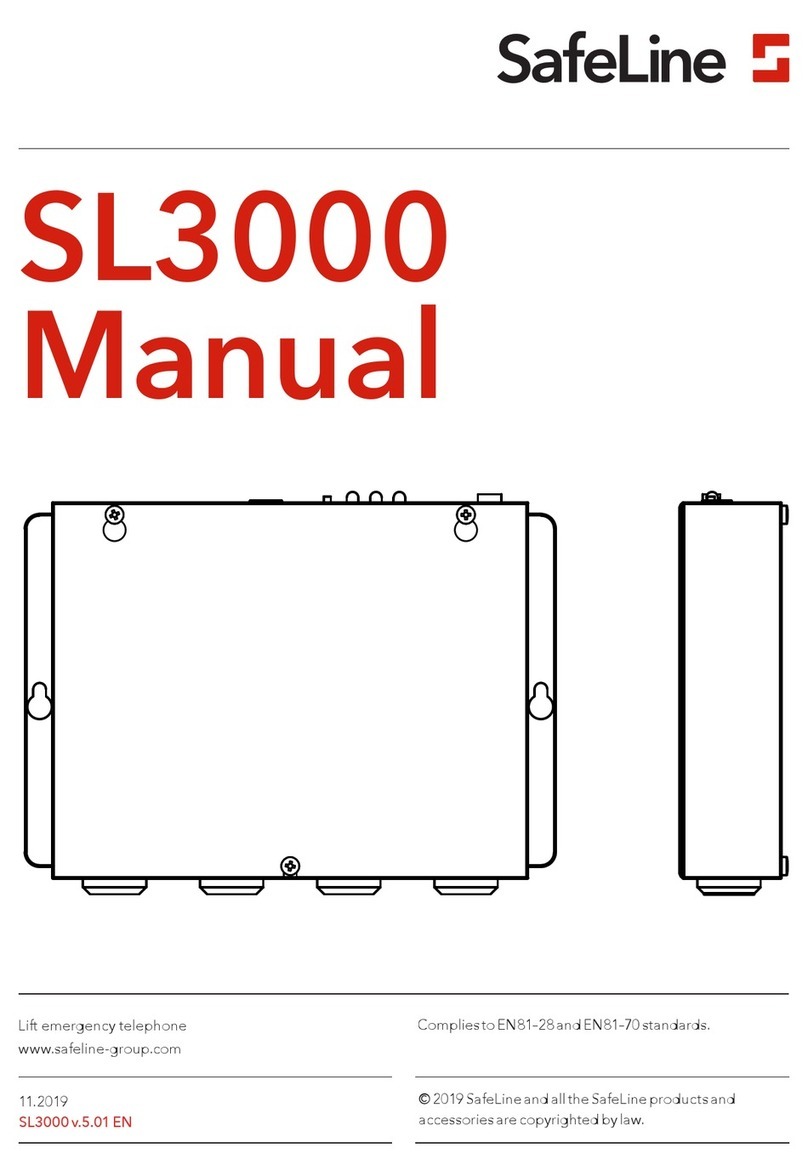
Safeline
Safeline SL3000 manual
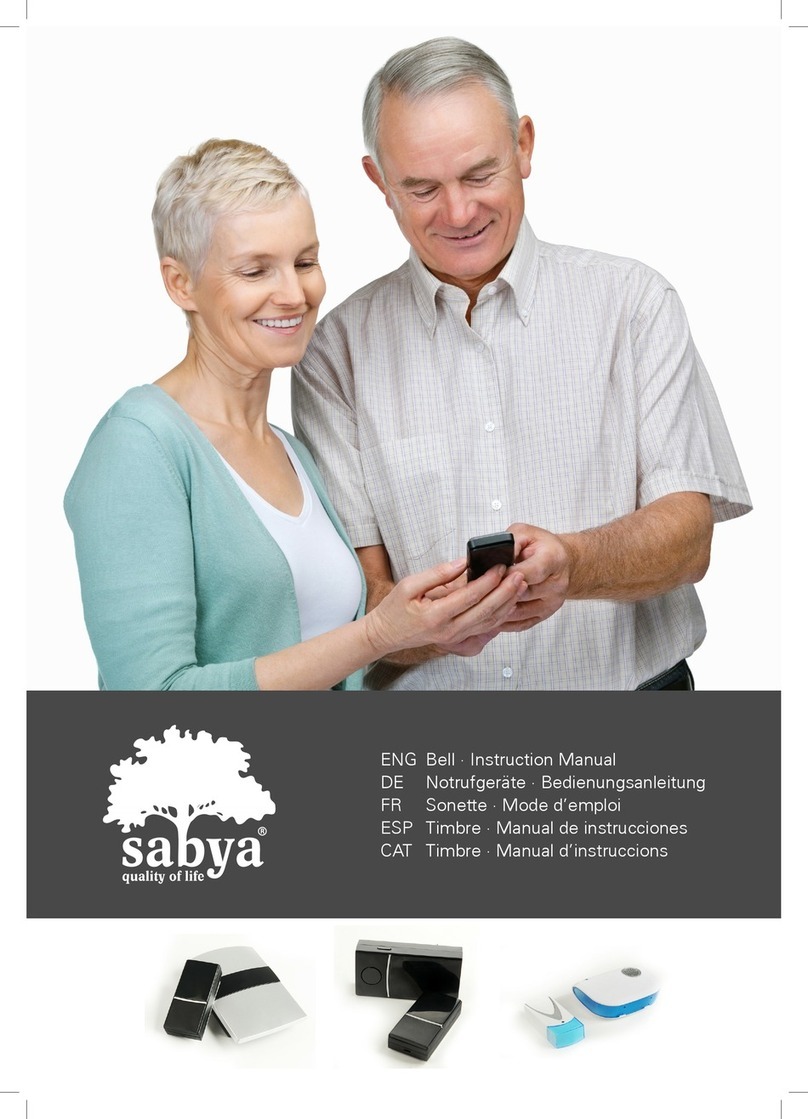
sabya
sabya Grey bell instruction manual
